Originally posted on February 10, 2024 @ 6:36 pm
Have you ever wondered if you can plant organic potatoes from the grocery store? The good news is, you can! Growing your own organic potatoes can be a satisfying and rewarding experience. Not only can it save you money, but it also allows you to have control over the quality and freshness of your produce.
But before you rush to grab a bag of grocery store potatoes, there are a few things you need to know. Grocery store potatoes may contain pathogens such as blight or fusarium, which could potentially harm your garden soil. To mitigate this risk, consider growing sprouted potatoes in containers rather than directly in the ground.
Table of Contents
Key Takeaways
- You can plant organic potatoes from the grocery store and enjoy a bounty of delicious homegrown produce.
- Grocery store potatoes may harbor pathogens, so it’s recommended to grow sprouted potatoes in containers to protect your garden soil.
- Growing your own organic potatoes allows you to have control over the quality and freshness of your produce.
- Consider incorporating other organic gardening practices to enhance the health and productivity of your potato plants.
- Starting a home garden and growing your own organic produce is a sustainable and fulfilling way to enjoy fresh vegetables.
Are Store-Bought Potatoes Safe to Grow?
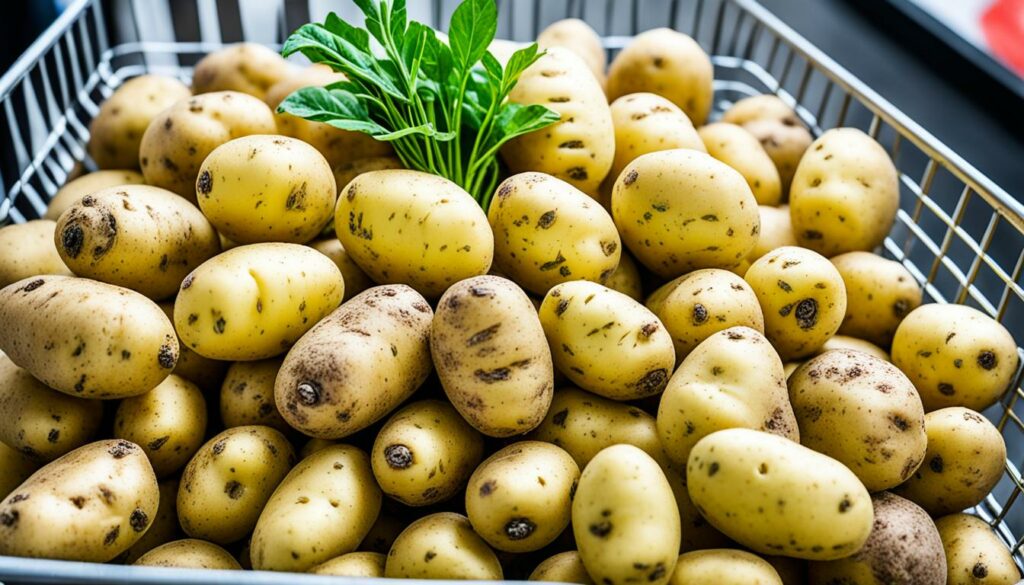
Many people wonder if store-bought potatoes can be grown in their own gardens. The answer is yes, you can grow store-bought potatoes in your garden and enjoy a bountiful harvest. However, there are a few things to consider before planting them.
Unlike seed potatoes that have been certified as disease-free, grocery store potatoes may carry pathogens such as blight or fusarium. These pathogens can potentially infect your garden soil and affect the health and yield of your potato plants. It’s important to be aware of this risk and take the necessary precautions to mitigate it.
To reduce the chances of introducing diseases into your garden, one option is to grow sprouted potatoes in a container. This allows you to control the growing environment and minimize the potential spread of pathogens. By planting store-bought potatoes in a container, you can enjoy homegrown potatoes while minimizing the risk to your garden.
Benefits of Growing Sprouted Potatoes in a Container
Growing sprouted potatoes in a container offers several benefits:
- Controlled Environment: Containers provide a controlled environment, allowing you to regulate factors such as soil quality, moisture levels, and sunlight exposure.
- Reduced Disease Risk: Planting in a container reduces the risk of introducing diseases into your garden soil, as the container acts as a barrier against soil-borne pathogens.
- Convenience: Containers can be placed in any suitable location, making them ideal for small spaces like patios or balconies.
- Portability: Containers can be moved easily, enabling you to follow the sun or protect the plants from extreme weather.
Growing store-bought potatoes in containers can be a rewarding and successful way to enjoy homegrown potatoes while minimizing the risk to your garden.
Next, we will explore the step-by-step process of growing store-bought potatoes, both in the garden and in containers.
| Advantages | Disadvantages |
|---|---|
| Provides control over the growing environment | Potential risk of introducing diseases to garden soil |
| Allows for easy portability and placement in various locations | Requires careful monitoring of moisture levels |
| Minimizes space requirements | May limit the quantity of potatoes that can be grown |
How to Grow Store-Bought Potatoes
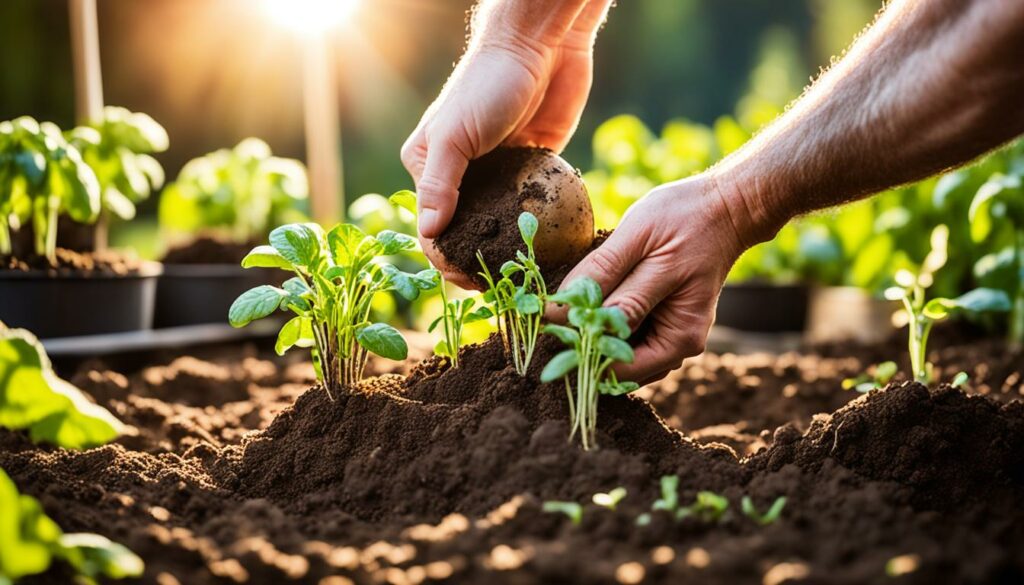
Growing store-bought potatoes is a simple and rewarding process. By following a few organic potato planting tips, you can enjoy a bountiful harvest of fresh, homegrown potatoes. Here’s a step-by-step guide to get you started:
- Hold onto the sprouted potatoes: When you find sprouted potatoes at the grocery store, don’t discard them. Instead, keep them until planting time in the spring, when the soil temperatures reach around 45 degrees F.
- Prepare the soil: Choose a location in your garden that receives at least six hours of sunlight per day. The soil should be loose and fine, allowing the potatoes to grow easily. Work the soil to a depth of 8 to 12 inches, removing any rocks or debris.
- Plant the potatoes: Dig a hole about 4 inches deep and place the sprouted potato in the hole with the eyes facing up. Space each potato about 12 inches apart to allow room for growth. Cover the potatoes with soil, gently patting it down.
- Maintain optimal moisture: Keep the soil moist but not soggy during the growing season. Water the potatoes regularly, especially during dry spells. Avoid overwatering, as it can lead to rot and other diseases.
Throughout the growing season, your potatoes will begin to develop leafy green tops above the soil. As the plants grow, continue to add soil around the base of the plants to promote tuber formation and protect the developing potatoes from sunlight, which can turn them green and make them bitter.
Remember: “The key to successful potato planting is ensuring the right conditions for growth. From choosing the right sprouted potatoes to providing the right amount of sunlight and moisture, each step is crucial for a productive harvest.”
With proper care and attention, you’ll be able to enjoy the satisfaction of harvesting your own homegrown potatoes. Let’s take a look at the different potato varieties you can grow:
| Potato Variety | Characteristics |
|---|---|
| Russet Potatoes | High starch content, perfect for baking and mashing. |
| Yukon Gold Potatoes | Buttery flavor, ideal for roasting and boiling. |
| Red Potatoes | Waxy texture, excellent for salads and boiling. |
As you can see, different potato varieties have distinct characteristics that make them suitable for specific culinary uses.
By following these organic potato planting tips, you can experience the joy of growing your own fresh and flavorful potatoes. Not only does it ensure a supply of organic produce, but it also allows you to take control of your food and reduce your carbon footprint. So go ahead, get your hands dirty, and start planting those store-bought potatoes!
Growing Store-Bought Potatoes in Containers
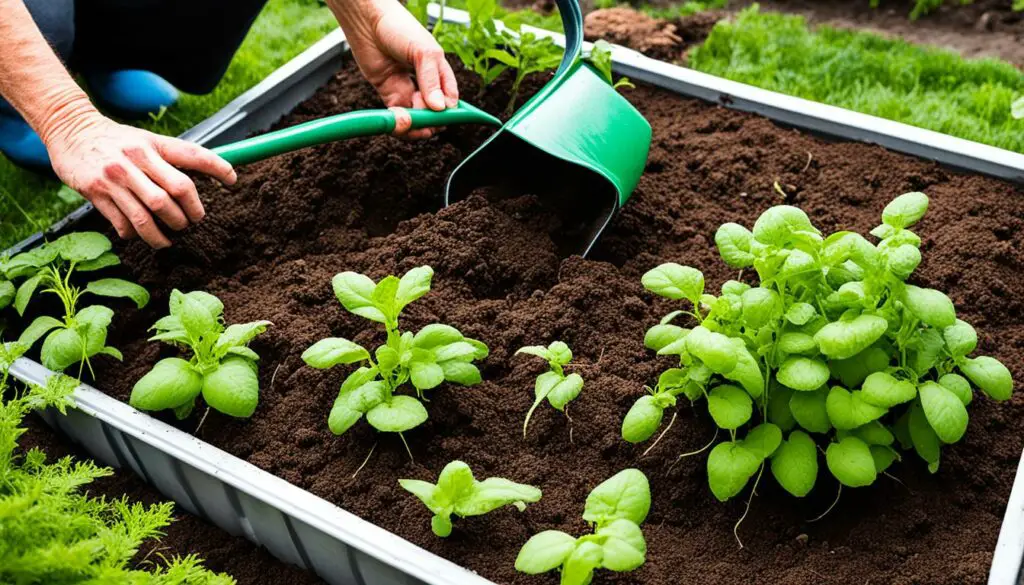
If you want to avoid introducing diseases into your garden soil, consider growing store-bought potatoes in containers. This method provides a controlled environment that minimizes the risk of soil-borne pathogens affecting your crop. Plus, growing potatoes in containers offers several advantages, such as better pest control and easier maintenance.
To get started, here are some organic potato planting tips for successful container gardening:
- Choose the right container: Use a large container with drainage holes to ensure proper water drainage and prevent waterlogging. A 10-15 gallon container is ideal for growing 2-3 potato plants.
- Prepare the soil: Use moistened potting soil mixed with compost for optimal nutrition. Avoid using garden soil, as it may contain pests or diseases.
- Plant the potatoes: Place the sprouted potatoes in the container, with the sprouts facing upwards. Plant them about 4 inches deep to encourage root development.
- Provide proper care: Keep the soil consistently moist but not waterlogged. Monitor the container for any signs of pests or diseases, and take necessary measures to prevent or control them.
- Support the growing plants: As the potato plants grow, provide support by adding soil or straw around the stems. This practice, known as hilling, helps protect the tubers from sunlight exposure and encourages more potatoes to form.
Tip: To maximize space and yield, you can even try vertical gardening by using tall containers or stacking containers on top of each other. Just ensure that each container has sufficient drainage.
By following these organic potato planting tips, you can enjoy a bountiful harvest of homegrown organic potatoes right from the convenience of your own patio or balcony. Remember to choose organic potatoes from the supermarket to ensure you’re starting with a healthy and untreated source.
Potato Container Comparison
| Container Type | Advantages | Disadvantages |
|---|---|---|
| Traditional Pots |
|
|
| Grow Bags |
|
|
| Smart Pots |
|
|
Choose the container type that suits your needs and available space. All three options provide suitable environments for growing store-bought potatoes and can deliver a satisfying harvest of fresh, organic tubers.
Tips for Successful Potato Planting
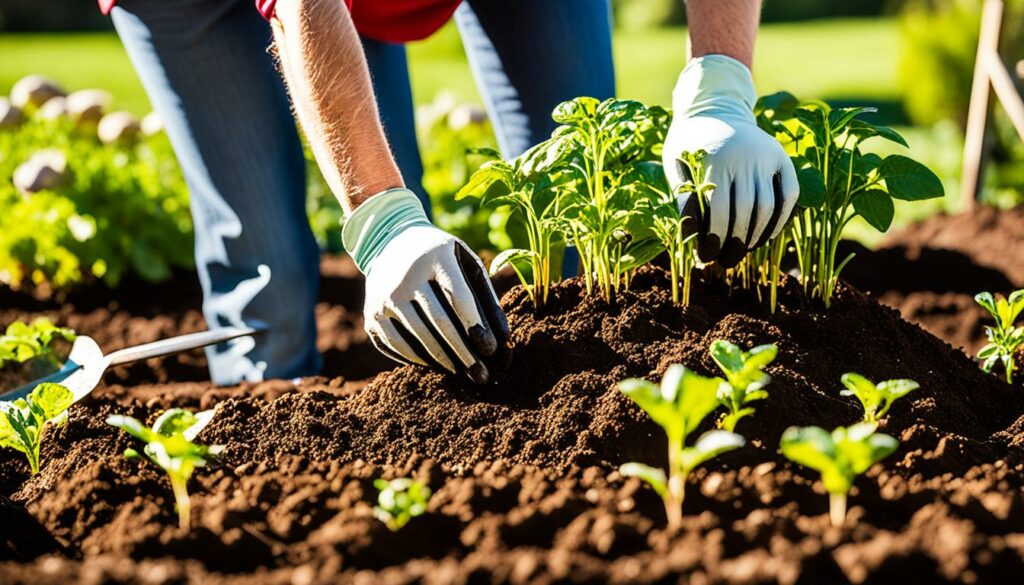
When it comes to planting organic potatoes, following a few key tips can greatly increase your chances of a successful harvest. Whether you’re growing organic potatoes at home or starting with store-bought potatoes from the supermarket, these strategies will set you up for success.
Prepare the Soil
Before planting your potatoes, it’s essential to prepare the soil properly. Work the soil to a depth of 8 to 12 inches, removing any rocks, weeds, or other debris. This will ensure that the soil is loose and well-drained, promoting healthy root development. Incorporating organic compost or slow-release fertilizer will provide the essential nutrients your potato plants need to thrive.
Cut and Cure Potatoes
If you are using large potatoes, it’s a good idea to cut them into pieces with at least one eye each. This will allow you to maximize your potato yield, as each piece has the potential to grow into a new plant. After cutting, it’s essential to cure the potato pieces before planting. Curing involves allowing the cut surfaces to dry and form a protective layer, which helps prevent rotting and promotes healthy growth.
Planting Depth and Soil Hilling
When it’s time to plant your potatoes, make sure to bury them at the right depth. Plant them approximately 4 inches deep, placing the cut side facing down and the eyes facing up. This will ensure that the sprouts can easily emerge from the soil. As your potato plants grow, it’s important to hill the soil around the base of the plants. Hilling involves mounding soil around the stems, which helps promote more tuber development and prevents the potatoes from turning green.
| Tips for Successful Potato Planting | |
|---|---|
| 1. | Prepare the soil by working it to a depth of 8 to 12 inches and incorporating organic compost or slow-release fertilizer. |
| 2. | Cut large potatoes into pieces with at least one eye each and cure them before planting to promote healthy growth. |
| 3. | Plant the potatoes approximately 4 inches deep with the cut side down and the eyes facing up. |
| 4. | Hill the soil around the base of the plants as they grow to promote more tuber development. |
Following these organic potato planting tips will give you the best chance of growing a bountiful harvest of delicious, homegrown potatoes. By providing the right growing conditions and proper care, you’ll be rewarded with healthy plants and a plentiful supply of organic potatoes for your kitchen.
The Benefits of Sprouting Potatoes
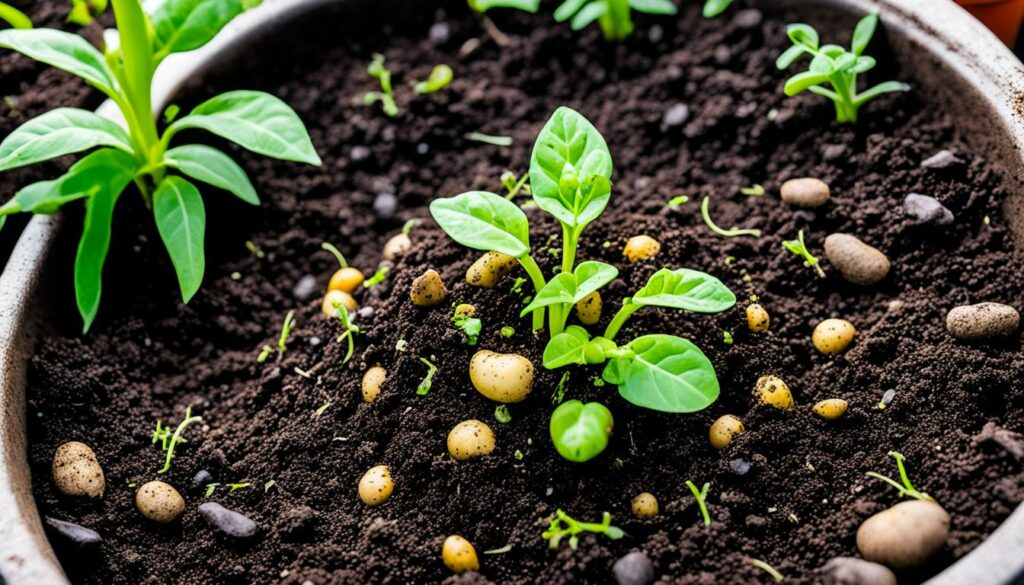
Sprouting potatoes before planting can have significant advantages for your organic garden. By sprouting store-bought potatoes, you not only make use of a waste product but also increase your crop yield and maximize your resources. This section will explore the benefits of sprouting potatoes and how it can contribute to growing organic potatoes from store-bought produce.
Sprouting potatoes allow you to harness the potential of each potato, as multiple plants can grow from a single sprouted potato. This means that you can significantly increase your harvest without needing to purchase additional seed potatoes.
“By sprouting store-bought potatoes, you can turn a waste product into a productive crop, effectively using the resources you already have.”
Growing organic produce from grocery store items is not only cost-effective but also sustainable. Instead of discarding or composting sprouted potatoes, you can transform them into thriving plants that produce an abundant crop of delicious, organic potatoes.
Considerations for Growing Store-Bought Potatoes
While growing store-bought potatoes can be a fun and economical experiment, it’s important to note that they may not produce as well as certified seed potatoes. Store-bought potatoes are not certified to be disease-free and may be less productive than seed potatoes. If you’re serious about growing a good crop of potatoes, it’s best to invest in high-quality seed potatoes.
Tips for maximizing your potato harvest
- Choose high-quality seed potatoes: Investing in certified disease-free seed potatoes ensures a greater chance of a successful and bountiful harvest.
- Practice crop rotation: To reduce the risk of soil-borne diseases, avoid planting potatoes in the same spot year after year. Rotate your potato crop with other vegetables.
- Provide proper nutrition: Prior to planting, enrich your soil with organic matter and incorporate balanced fertilizer to provide the necessary nutrients for healthy potato growth.
- Maintain consistent watering: Potatoes require regular watering, particularly during dry spells. Ensure the soil remains consistently moist but not waterlogged to promote optimal growth.
- Monitor for pests and diseases: Regularly inspect your potato plants for signs of pests or diseases. Take suitable measures to control any issues that may arise.
Remember, successful potato cultivation involves careful attention to detail and the implementation of proper growing techniques. While planting store-bought potatoes can be a rewarding experience, it’s essential to understand the potential limitations and take appropriate measures to maximize your harvest.
Growing Potatoes as an Experiment
https://www.youtube.com/watch?v=2am26vsfeL8
Growing organic potatoes at home can be an exciting and rewarding experiment. It’s a chance to explore the wonders of nature and witness the transformation of a simple spud into a delicious harvest. Additionally, planting organic vegetables from the supermarket or growing organic produce from the grocery store can be a sustainable and eco-friendly choice.
By taking store-bought potatoes that have sprouted and planting them in your garden or containers, you can turn what would otherwise be considered waste into a thriving crop. This not only saves money but also reduces food waste, making it a win-win situation.
While the results of growing store-bought potatoes may vary, it’s important to approach it as a learning experience. Remember that grocery store potatoes may not be certified disease-free like seed potatoes. However, with the right techniques and care, you can successfully grow your own organic potatoes.
Here are some tips to help you get started:
- Choose organic potatoes from the supermarket that have sprouted.
- If planting in the ground, prepare the soil by working it to a depth of 8 to 12 inches and incorporating organic compost or slow-release fertilizer.
- If planting in containers, use a large container with drainage holes and fill it with moistened potting soil.
- Plant the sprouted potatoes 4 inches deep in loose, fine soil or potting mix, with the eyes facing up.
- Keep the soil moist but not waterlogged during the growing season.
- As the plants grow, you can help them develop by gently hilling soil or adding straw around the stems.
“Growing potatoes from store-bought sprouts is a delightful experiment. With some care and patience, you’ll be rewarded with a bountiful harvest of homegrown, organic potatoes.”
Remember, growing organic potatoes from the grocery store is not just about the end result—it’s also about the joy of nurturing plants and witnessing their growth. So, roll up your sleeves, get your hands dirty, and embark on this exciting gardening adventure!
Conclusion
Planting organic potatoes from the grocery store is an accessible and rewarding way to enjoy a bountiful harvest. Whether you choose to grow them in the ground or in containers, following the recommended steps and tips can help ensure a successful garden. This article has provided valuable insights into organic gardening for beginners, offering guidance on how to start a home garden and grow your own organic produce.
By utilizing sprouted potatoes from the grocery store, you can transform what may have been wasted into a sustainable source of fresh vegetables. The process of sprouting and cultivating store-bought potatoes encourages resourcefulness and provides an opportunity to learn more about the joys of organic gardening.
Starting a home garden not only allows you to experience the satisfaction of growing your own food but also promotes a healthier and more environmentally friendly lifestyle. By growing organic produce from the grocery store, you can have peace of mind knowing exactly what goes into your food and have the assurance of consuming pesticide-free, nutrient-rich vegetables.
FAQ
Can I plant organic potatoes from the grocery store?
Yes, you can plant organic potatoes from the grocery store and they are safe to consume. However, keep in mind that store-bought potatoes may carry pathogens such as blight or fusarium. To minimize the risk of introducing disease into your garden, consider growing sprouted potatoes in a container.
How do I grow store-bought potatoes?
To grow store-bought potatoes, wait until spring when the soil temperatures reach 45 degrees F. Plant the potatoes 4 inches deep in loose, fine soil with the eyes facing up. Keep the soil moist but not soggy during the growing season.
Can I grow store-bought potatoes in containers?
Yes, growing store-bought potatoes in containers is a great option if you want to avoid introducing diseases into your garden soil. Use a large container with drainage holes and plant the potatoes 4 inches deep in moistened potting soil. As the plant grows, layer soil and straw around the plant’s stem.
What are some tips for successful potato planting?
Before planting, work the soil to a depth of 8 to 12 inches and incorporate organic compost or slow-release fertilizer. Cut large potatoes into pieces with at least one eye and cure them before planting. Plant the potatoes 4 inches deep and hill soil around the base of the plants as they grow.
What are the benefits of sprouting potatoes?
Sprouting potatoes before planting can increase your yield and allow for multiple plants to grow from a single potato. This is a great way to maximize your resources and turn a waste product into a productive crop.
Should I consider any factors when growing store-bought potatoes?
Yes, it’s important to note that store-bought potatoes may not produce as well as certified seed potatoes. They are not certified to be disease-free and may be less productive. If you’re serious about growing a good crop of potatoes, it’s recommended to invest in high-quality seed potatoes.
Can I grow store-bought potatoes as an experiment?
Absolutely! Growing store-bought potatoes can be a fun garden experiment and a chance to learn more about the growing process. While the results may vary, planting sprouted store-bought potatoes can be a rewarding experience.
What are the benefits of starting a home garden?
Starting a home garden and growing your own organic produce is a rewarding and sustainable way to enjoy fresh vegetables. It allows you to have control over the quality of the food you eat and can also save you money in the long run.
Source Links
- https://rootedrevival.com/grow-store-bought-potatoes/
- https://www.gardeningknowhow.com/edible/vegetables/potato/can-you-grow-store-bought-potatoes.htm
- https://permies.com/t/1005/plant-organic-store-bought-Potatoes
See also:
Leave a Reply